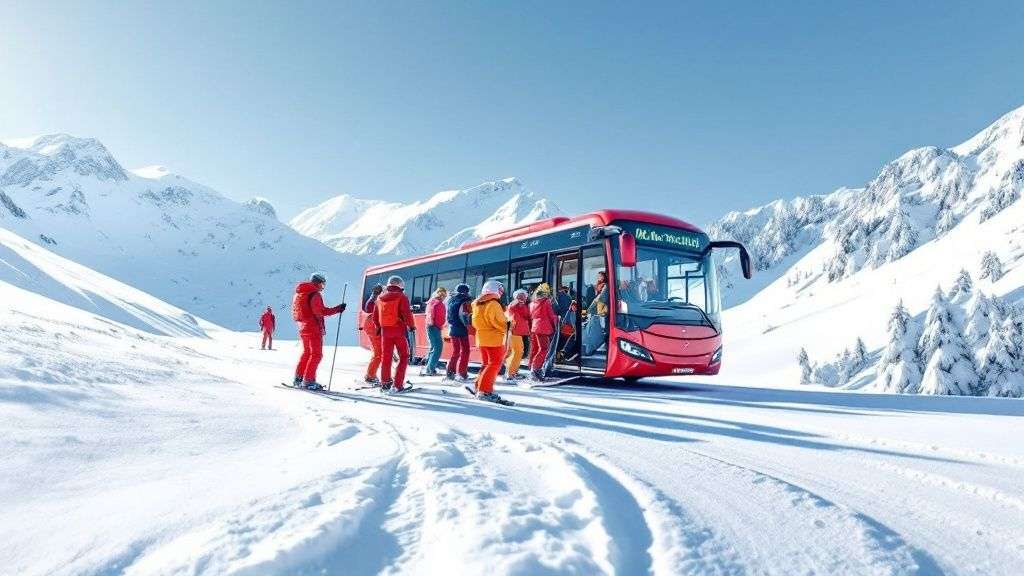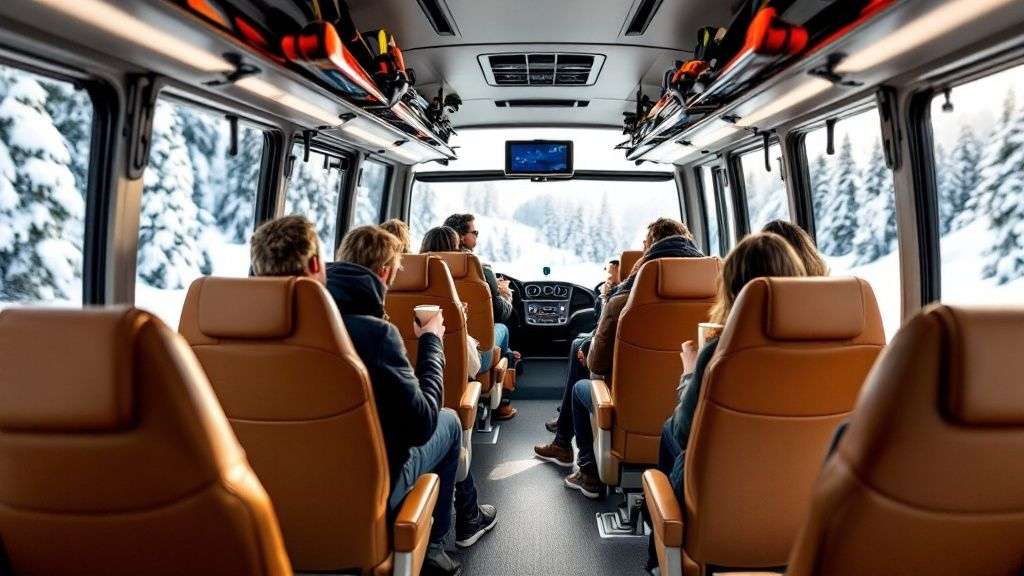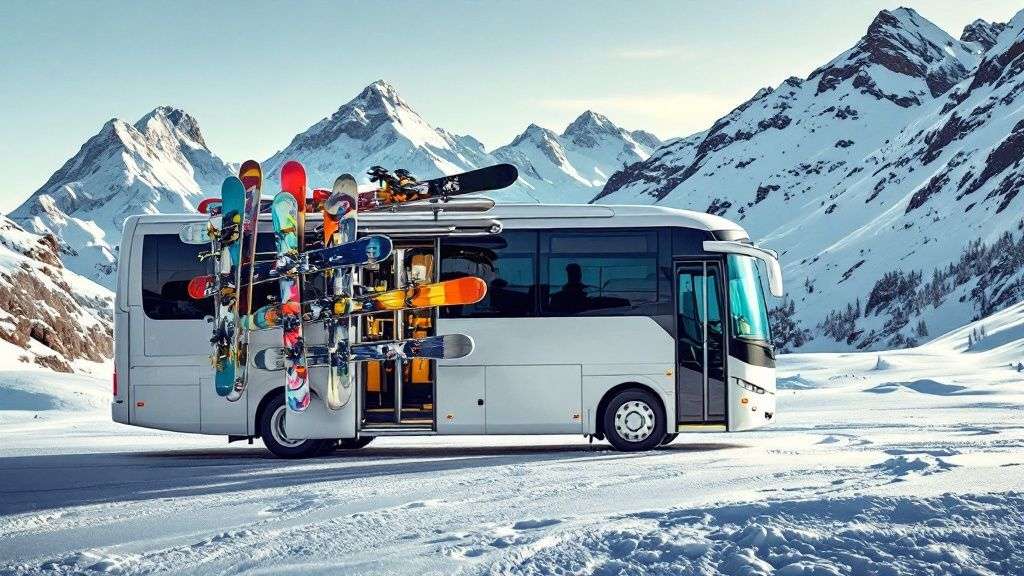Your Complete Guide to the Utah Ski Bus
Everything you need to know about riding the UTA ski bus to Alta, Snowbird, Brighton, and Solitude. Learn routes, schedules, fares, and local tips.
The Utah Ski Bus is your ticket to the legendary powder of Little and Big Cottonwood Canyons, letting you sidestep the headache of canyon driving, parking nightmares, and traction laws. This guide covers what the ski bus is, when it runs, and how to use it, with actionable tips to ride to Alta, Snowbird, Brighton, and Solitude like a local. It's the smartest way to guarantee an amazing day on the mountain.
What is the Utah Ski Bus?
The Utah Ski Bus is a public transit service designed to move skiers and snowboarders from Salt Lake Valley park-and-ride lots directly to the base of the four Cottonwood Canyon resorts: Alta, Snowbird, Brighton, and Solitude. Operated by the Utah Transit Authority (UTA) ski bus service, these buses are equipped for harsh winter conditions with exterior gear racks, making them a safe and efficient alternative to driving. Think of it as your personal chauffeur to the slopes.

Choosing the Utah ski bus unlocks significant benefits that improve your mountain experience.
- Avoids Stress: Forget white-knuckle driving on icy roads and the scramble for parking spots, which often fill before 8 AM on weekends and powder days.
- Saves Money: A one-way fare is just $5.00. Better yet, many season passes, including the Ikon Pass, provide free rides.
- Enhances Safety: UTA drivers are trained professionals who handle extreme winter conditions in buses built to manage snow and ice, ensuring you get up and down the canyon safely.
- Protects the Canyons: Every full bus removes dozens of cars from the road, reducing congestion and emissions in the fragile canyon ecosystem.
Today's service is the result of decades of refinement. Since its start in 1975, the system has evolved into a sophisticated network thanks to partnerships with the resorts, forged to tackle canyon congestion head-on. You can read more about the evolution of Utah's ski transit to see how it became a vital part of local ski culture.
When Does the Ski Bus Run?
The Utah Ski Bus is a seasonal service tied directly to resort operations, typically running from early December through mid-April. The system is built around high-frequency schedules during peak travel times, ensuring you can get to the slopes for the first chair and get home after the last.

Key Schedules and Frequencies
- Morning Peak (Uphill): From roughly 6:00 AM to 10:00 AM, buses run every 15 minutes on the most popular routes.
- Afternoon Peak (Downhill): From 3:00 PM to 6:00 PM, buses again run every 15 minutes to bring skiers back down the canyons.
- Mid-day & Evening: Outside of peak hours, service continues every 30-60 minutes. Some routes offer late-night service to accommodate night skiing.
These schedules are designed for reliability, but mountain weather can cause delays. Always check the official UTA schedule for exact times and check the real-time travel summary for Little Cottonwood Canyon or Big Cottonwood Canyon before you leave.
How to Ride the Utah Ski Bus
Using the ski bus is simple once you know the routes, where to park, and how to pay. The entire system is designed around connecting convenient park-and-ride lots in the valley to the resorts, letting you skip the most stressful part of a ski day.

Step 1: Find Your Route and Park & Ride
Your destination canyon determines your route. Each canyon has a primary bus route and several designated free park-and-ride lots.
| Canyon & Resorts Served | Route Number | Primary Park & Ride Lots |
|---|---|---|
| Little Cottonwood (Alta & Snowbird) | Route 994 | Historic Sandy TRAX Station, 9400 S & 2000 E |
| Big Cottonwood (Brighton & Solitude) | Route 972 | Midvale Fort Union TRAX, 6200 S & Wasatch Blvd, 7200 S & 2200 E |
- Local Tip: The lots closest to the canyon mouths fill up first. For a better chance at finding parking, use the larger lots further west, like the Historic Sandy TRAX Station for Little Cottonwood or the Midvale Fort Union TRAX Station for Big Cottonwood. Arrive early—aim for 30-45 minutes before you want to be on the bus, especially on weekends.
Step 2: Pay Your Fare
Paying is easy. A one-way fare is $5.00, but many riders travel for free.
- Season Pass: Many resort season passes (Ikon Pass, Alta, Snowbird, Brighton, Solitude) include free UTA access. Simply tap your pass on the electronic reader when you board.
- Contactless Payment: Tap your credit/debit card or mobile wallet (Apple/Google Pay) on the reader.
- UTA FAREPAY Card: Use UTA’s reloadable transit card for another tap-to-pay option.
Ridership is growing, with recent data from UTA's ridership gains and service enhancements showing a 4.3% jump in ski bus boardings last season. This trend underscores the importance of being prepared.
Step 3: Follow On-Board Etiquette
A few simple rules make the ride smoother for everyone.
- Gear Goes Outside: Skis and snowboards are never allowed inside the bus. You must place them in the external racks. Be ready to load your gear quickly to keep the line moving.
- Manage Your Pack: Keep backpacks on your lap or between your feet to ensure the aisle stays clear.
- Wear a Mask if Required: Follow all posted UTA health and safety guidelines.
Actionable, Local Tips for Riding the Bus
Riding the bus is easy, but riding it like a local can make your day completely seamless.

- Use the Transit App: This is a non-negotiable tool. It provides real-time GPS tracking of your bus, so you know exactly when to be at the stop. It often shows how full the approaching bus is, allowing you to wait for the next, less crowded one if needed.
- Leave Earlier to Go Home: The downhill rush between 3:30 PM and 5:00 PM is intense. To get a guaranteed seat and a faster ride down, aim to catch a bus between 2:30 PM and 3:15 PM. You’ll trade a few runs for a much more relaxed journey.
- Check Road Status First: Before leaving your hotel, check WasatchRoads.com or the UDOT Traffic app. Roads can close for avalanche control with little warning. A quick check can save you a wasted trip to a closed canyon. You can also view Little Cottonwood Canyon cameras to see traffic conditions live.
- Pack for Delays: Always have an extra layer, water, and a snack. Weather, accidents, or avalanche work can cause unexpected delays. Being prepared turns a potential ordeal into a minor inconvenience.
The Utah ski bus is an essential part of the ski experience here, and its importance is growing. Recent ridership trends and service improvements show a clear commitment to making it the most reliable and sustainable way to access the mountains.
Frequently Asked Questions
Can I bring my ski boots on the bus?
Yes, you can wear your ski boots on board. However, many locals prefer to ride in comfortable shoes and change at the base of the resort. Skis and snowboards must always be placed in the exterior racks and are not allowed inside the cabin.
Is the ski bus free with my Ikon Pass?
Yes, the Ikon Pass and Ikon Base Pass typically include free transportation on the UTA Ski Bus. Most individual resort season passes for Alta, Snowbird, Brighton, and Solitude also include this benefit. Always confirm with your pass provider for the current season's perks.
What happens if the canyon road closes while I'm on the bus?
If the road closes for avalanche control or an accident, the ski bus service will pause. Buses will hold their position until UDOT gives the all-clear for traffic to resume. This is a normal part of canyon travel; your UTA driver is trained for these situations.
For more answers, visit our comprehensive FAQ page.
At Wasatch Travel Helper, we're here to make your trip to the canyons as smooth as possible. Use our real-time data to plan your next adventure at https://wasatchroads.com.